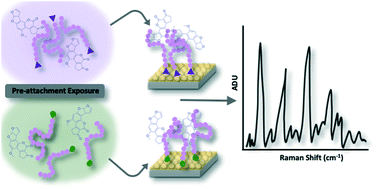当前位置:
X-MOL 学术
›
Mol. Syst. Des. Eng.
›
论文详情
Our official English website, www.x-mol.net, welcomes your feedback! (Note: you will need to create a separate account there.)
Optimizing linear polymer affinity agent properties for surface-enhanced Raman scattering detection of aflatoxin B1†
Molecular Systems Design & Engineering ( IF 3.6 ) Pub Date : 2019-07-03 , DOI: 10.1039/c9me00032a Victoria M. Szlag 1, 2, 3, 4 , Rebeca S. Rodriguez 1, 2, 3, 4 , Seyoung Jung 2, 3, 4, 5 , Marc R. Bourgeois 6, 7, 8, 9 , Samuel Bryson 1, 2, 3, 4 , Anatolii Purchel 1, 2, 3, 4 , George C. Schatz 6, 7, 8, 9 , Christy L. Haynes 1, 2, 3, 4 , Theresa M. Reineke 1, 2, 3, 4
Molecular Systems Design & Engineering ( IF 3.6 ) Pub Date : 2019-07-03 , DOI: 10.1039/c9me00032a Victoria M. Szlag 1, 2, 3, 4 , Rebeca S. Rodriguez 1, 2, 3, 4 , Seyoung Jung 2, 3, 4, 5 , Marc R. Bourgeois 6, 7, 8, 9 , Samuel Bryson 1, 2, 3, 4 , Anatolii Purchel 1, 2, 3, 4 , George C. Schatz 6, 7, 8, 9 , Christy L. Haynes 1, 2, 3, 4 , Theresa M. Reineke 1, 2, 3, 4
Affiliation

|
A series of poly(N-acryloyl glycinamide) (pNAGA) polymers were synthesized and studied as capture agents for surface-enhanced Raman scattering (SERS) detection of aflatoxin B1 (AFB1), a highly carcinogenic food-borne toxin. Four molecular weights of pNAGA were synthesized by reversible addition-fragmentation chain-transfer (RAFT) polymerization to study the dependence of affinity agent efficacy on chain length for this AFB1 sensing platform. Isothermal titration calorimetry (ITC) was used to verify the sign and magnitude of the enthalpic effects involved in polymer–AFB1 interactions in solution and to understand the effects of pNAGA chain length on AFB1 noncovalent binding. pNAGA–AFB1 interactions were found to be exothermic, and longer pNAGA chains generally resulted in smaller enthalpy decreases per repeat unit. With pNAGA22 being thermodynamically the strongest affinity agent, we hypothesize that AFB1 affinity is determined by a balance between the configurational restrictions in pNAGA chains and the enthalpic advantage of binding AFB1. SERS spectral changes observed following AFB1 exposure were used to evaluate the influence of polymer molecular weight (2.0–5.2 kDa), order of attachment (pre- vs. post- functionalization of the substrate) and attachment chemistry (thiol vs. trithiocarbonate) on the sensitivity of AFB1 detection. The method by which target, polymer affinity agent, and signal transduction mechanism are combined was found to have significant impacts on the achieved sensitivity. The most effective polymer chain length (pNAGA22), anchoring chemistry (thiol), and polymer/toxin assembly scheme (in-solution) allowed detection of 10 ppb AFB1 in water (below the FDA regulatory limit of 20 ppb), a hundred-fold improvement over SERS sensing without the pNAGA affinity agent.
中文翻译:

优化用于表面增强拉曼散射检测黄曲霉毒素B1的线性聚合物亲和剂性能†
一系列的poly(N合成了丙烯酰甘氨酰胺(pNAGA)聚合物,并将其用作捕获剂,用于表面增强拉曼散射(SERS)检测黄曲霉毒素B1(AFB1)(一种高度致癌的食源性毒素)。通过可逆加成-断裂链转移(RAFT)聚合合成了四种分子量的pNAGA,以研究亲和剂功效对该AFB1传感平台的链长的依赖性。等温滴定热法(ITC)用于验证溶液中聚合物与AFB1相互作用所涉及的焓效应的迹象和强度,并了解pNAGA链长对AFB1非共价结合的影响。发现pNAGA-AFB1相互作用是放热的,较长的pNAGA链通常导致每个重复单元的焓降低较小。使用pNAGA 22作为热力学上最强的亲和剂,我们假设AFB1亲和力是由pNAGA链中的构型限制与结合AFB1的焓优势之间的平衡决定的。SERS光谱变化观察到以下AFB1曝光被用来评价聚合物的分子量(kDa的2.0-5.2),附件的顺序的影响(预对衬底的后官能化)和附着化学(硫醇与三硫代碳酸酯)的AFB1检测的灵敏度。发现结合靶标,聚合物亲和剂和信号转导机制的方法对获得的灵敏度有重大影响。最有效的聚合物链长(pNAGA 22),锚定化学(硫醇)和聚合物/毒素组装方案(溶液中)可以检测到水中10 ppb AFB1(低于FDA规定的20 ppb限制),比不具有pNAGA亲和力的SERS传感提高了100倍代理人。
更新日期:2019-10-07
中文翻译:

优化用于表面增强拉曼散射检测黄曲霉毒素B1的线性聚合物亲和剂性能†
一系列的poly(N合成了丙烯酰甘氨酰胺(pNAGA)聚合物,并将其用作捕获剂,用于表面增强拉曼散射(SERS)检测黄曲霉毒素B1(AFB1)(一种高度致癌的食源性毒素)。通过可逆加成-断裂链转移(RAFT)聚合合成了四种分子量的pNAGA,以研究亲和剂功效对该AFB1传感平台的链长的依赖性。等温滴定热法(ITC)用于验证溶液中聚合物与AFB1相互作用所涉及的焓效应的迹象和强度,并了解pNAGA链长对AFB1非共价结合的影响。发现pNAGA-AFB1相互作用是放热的,较长的pNAGA链通常导致每个重复单元的焓降低较小。使用pNAGA 22作为热力学上最强的亲和剂,我们假设AFB1亲和力是由pNAGA链中的构型限制与结合AFB1的焓优势之间的平衡决定的。SERS光谱变化观察到以下AFB1曝光被用来评价聚合物的分子量(kDa的2.0-5.2),附件的顺序的影响(预对衬底的后官能化)和附着化学(硫醇与三硫代碳酸酯)的AFB1检测的灵敏度。发现结合靶标,聚合物亲和剂和信号转导机制的方法对获得的灵敏度有重大影响。最有效的聚合物链长(pNAGA 22),锚定化学(硫醇)和聚合物/毒素组装方案(溶液中)可以检测到水中10 ppb AFB1(低于FDA规定的20 ppb限制),比不具有pNAGA亲和力的SERS传感提高了100倍代理人。



























 京公网安备 11010802027423号
京公网安备 11010802027423号